Fire Resistance of Prestressed Multispan Steel Truss Composite Slab
Abstract
:1. Introduction
2. Materials and Methods
2.1. Specimen Design
2.2. Material Properties
2.3. Arrangement of Measurement Points
2.4. Fire Experiment Design
3. Experiments and Analysis
3.1. First Fire Experiment
3.2. Second Fire Experiment
3.3. Failure Mode and Analysis of Specimens
- (1)
- During the experiment, a transverse crack perpendicular to the span of the slab was initiated at the truncated position of the negative moment reinforcement near the upper support. At the conclusion of the experiment, this crack exhibited the maximum width, leading to the fracture of the composite layer. The primary reason behind this phenomenon was that the lower region of the slab, being closer to the heat source, experienced a greater temperature rise and underwent larger deformation due to heating. As a result, it generated tensile stress in the upper region, which experienced relatively smaller deformation, known as temperature-induced stress, caused by the temperature gradient. Under the combined action of load and temperature, the tensile zone in the upper region gradually extended outward along the span direction from the support. As a result, the negative moment reinforcement, originally situated within the compressive zone, entered the tensile zone at its truncated location. Furthermore, all of the tensile stresses in this specific position were borne by the concrete, leading to a concentration of tensile forces and initiating the initial cracking of the concrete. Consequently, the concrete experienced the initial cracking.
- (2)
- After the exposure to the fire event, a substantial number of cracks developed at the midspan supports of the slab during the experiment. This occurrence could be attributed to several factors. Firstly, as the temperature rose, the generated temperature-induced stress gradually intensified. Furthermore, the influence of the fire on material properties and potential cracking at the bottom of the slab led to variations in the structural stiffness along the span. This, in turn, resulted in a redistribution of internal forces, leading to an increase in the negative bending moments at the supports. Concurrently, both the crack resistance and flexural bearing capacity of the slab diminished due to the effects of load–temperature coupling. Consequently, the load-carrying capacity of the supports fell short of the required level, ultimately giving rise to transverse cracks perpendicular to the span of the slab at the support locations.
- (3)
- During the fire experiment, longitudinal cracks along the span direction of the slab were observed. The analysis of the reasons for this phenomenon revealed that although temperature gradients induced tensile stresses in the upper region of the slab, the presence of applied loads resulted in compressive stresses in the upper midspan region under the combined effect of load and temperature. Therefore, transverse cracks perpendicular to the span did not develop in the upper midspan region. However, along the span direction, there were tensile stresses induced by temperature gradients, leading to the formation of longitudinal cracks. Additionally, the interface between the precast and postcast layers experienced damage due to the effects of temperature. The steel truss connected the precast layer with the postcast layer, causing the expansion of the precast layer due to heating. As a result, the postcast layer was subjected to forces along the vertical span direction through the steel truss, resulting in a concentration of tensile stresses at the location of the steel truss. Therefore, wider longitudinal cracks developed in that region.
- (4)
- When subjected to fire, the prestressed steel truss composite slabs exhibited a tendency to experience severe spalling, often resulting in the detachment of the precast layer as a unified entity. This spalling phenomenon was more pronounced compared to non-prestressed composite slabs, fully cast prestressed slabs, and single-span prestressed steel truss reinforced composite slabs. The underlying cause could be attributed to the precompression applied, which established an initial compressive state within the precast layer. Subsequent exposure to high temperatures induced additional compressive stresses due to temperature gradients, further contributing to the risk of bond failure at the interface, leading to delamination between the precast and postcast layers. Consequently, the precast layer transformed into a slender compressed plate, making it susceptible to instability-induced spalling under the influence of high-temperature steam. In comparison to the single-span simply supported prestressed steel truss composite slabs, the multispan composite slabs experienced higher levels of temperature-induced stresses during fire due to the lateral restraint provided by the supports, exacerbating the severity of the spalling. These observations highlight the importance of considering such behavior in the design and analysis of composite structures under fire conditions.
- (5)
- After the fire experiments, the precast layers and the postcast layers of the composite slabs showed delamination. The reasons for this were found to be as follows: The interface between the precast layer and the postcast layer was prepared with roughening treatment, as they were not poured simultaneously, leading to a limited bond strength between the two types of concrete. Under the high-temperature exposure during the fire, the slab experienced a gradual decrease in temperature from the exposed face to the back face. This temperature gradient induced tensile stresses at the interface, generating shear stresses between the two types of concrete. Consequently, when the shear stresses exceeded the bond strength, horizontal cracks and delamination occurred between the precast layer and the postcast layer. However, the presence of the steel truss embedded in the precast layer facilitated their combined behavior, highlighting the crucial role of steel trusses in ensuring the overall integrity of the component.
4. Results
4.1. Temperature Distribution within the Furnace during Fire Resistance Experiment
4.2. Temperature Field of Specimens
4.2.1. Temperature Field of Concrete
4.2.2. Temperature Field of Steel Reinforcement
4.3. Deformation of the Specimen
4.4. Deformation of Specimen Midspan Deflection as a Function of Furnace Temperature
4.5. Fire Resistance Limit
5. Conclusions
- (1)
- After being exposed to fire, the bottom of the multispan STPC slabs showed severe spalling, resulting in the significant detachment of the precast layer. This spalling was more pronounced than in the non-pre-stressed composite slabs and single-span prestressed steel truss composite slabs.
- (2)
- Under the coupled influence of temperature and load, the multispan prestressed steel truss composite slabs experienced horizontal cracks at the interface due to bond failure, yet the STPC slabs maintained satisfactory structural performance, which could be attributed to the presence of the steel bar truss.
- (3)
- Under the coupled influence of temperature and load, cracks occurred at the support point of the multispan prestressed steel truss composite slabs, where the negative reinforcement was cut. Considering fire resistance requirements, the anchorage length of the negative reinforcement at the slab support was appropriately extended.
- (4)
- The damage of the STPC slab specimens after fire was found to be more serious for those that had a thinner postcast concrete layer. In the single-span fire experiments, the structural performance of the unfired span was not prominently affected.
- (5)
- Due to the bursting and spalling of the precast layer, the thickness of the STPC slabs was reduced, resulting in decreases in the thermal insulation and the fire resistance limit. The fire resistance limits of the STPC slabs with 60 mm and 80 mm postcast concrete layers were 90 min and 130 min, respectively. When a high fire resistance limit of the STPC slab is required in design, it is recommended that the thickness of the postcast concrete layer be no less than 60 mm.
6. Future Work
Author Contributions
Funding
Data Availability Statement
Conflicts of Interest
References
- Cheng, J.Y.; Zhao, L.; Yang, J.J. Study on short-term rigidity of precast composite slab with steel truss and concrete. Adv. Mater. Res. 2013, 639–640, 198–205. [Google Scholar] [CrossRef]
- Favarato, L.F.; Gomes, A.V.S.; Candido, D.C.d.M.; Ferrareto, J.A.; Vianna, J.d.C.; Calenzani, A.F.G. On the composite behavior of a rebar truss ribbed slab with incorporated shuttering made of lipped channel section. J. Build. Eng. 2022, 55, 104663. [Google Scholar] [CrossRef]
- Wang, Q.; Ranzi, G.; Wang, Y.; Geng, Y. Long-term behaviour of simply-supported steel-bars truss slabs with recycled coarse aggregate. Constr. Build. Mater. 2016, 116, 335–346. [Google Scholar] [CrossRef]
- Li, W.J. Experimental Study and Analysis on Flexural Performance of Prestressed Concrete Composite Slabs. Ph.D. Thesis, Chongqing University, Chongqing, China, 2018. (In Chinese). [Google Scholar]
- Li, Y.X.; Jiang, L.; Yu, Z.Q.; Li, J.; Li, Y.W. Experiment research on the behaviors of steel bar truss and concrete superimposed floor slabs. In Applied Mechanics and Materials; Trans Tech Publications Ltd.: Xi’an, China, 2012; Volume 166, pp. 3–8. [Google Scholar]
- Zhao, L. Research on the Design and Calculation Method of Self-Anchored Steel Truss Reinforced Concrete Composite Slabs. Ph.D. Thesis, Central South University, Changsha, China, 2007. (In Chinese). [Google Scholar]
- Zhang, W.R. Research on the Design Method of Self-Anchored Steel Truss Prestressed Concrete Composite Slabs. Ph.D. Thesis, Shandong Jianzhu University, Jinan, China, 2015. (In Chinese). [Google Scholar]
- Ma, X.L. Research on the Mechanical Performance of Truss Reinforced Concrete Composite Slabs. Ph.D. Thesis, Southeast University, Nanjing, China, 2018. (In Chinese). [Google Scholar]
- Guo, S.; Bailey, C.G. Experimental behaviour of composite slabs during the heating and cooling fire stages. Eng. Struct. 2011, 33, 563–571. [Google Scholar] [CrossRef]
- Deng, L.B.; Wu, F.B.; Zhou, X.H.; Liu, B.; Li, J. Experimental study on fire resistance performance of prestressed concrete simply supported composite slabs. J. Build. Struct. 2015, 45, 65–70. (In Chinese) [Google Scholar]
- Deng, L.B.; Wu, F.B.; Zhou, X.H.; Liu, B.; Li, J. Parametric analysis of fire resistance performance for prestressed precast composite floor. Fire Sci. 2015, 24, 32–39. (In Chinese) [Google Scholar]
- Wang, Y.; Wang, G.; Huang, Z.; Li, L.; Bu, Y.; Zhong, B.; Zhang, Y.; Ma, S. Numerical modelling of in-plane restrained concrete two-way slabs subjected to fire. Fire Saf. J. 2021, 121, 103307. [Google Scholar] [CrossRef]
- Zhang, T. Experimental Study on Fire Resistance Performance of One-Way Simply Supported Composite Slabs. Ph.D. Thesis, Shandong Jianzhu University, Jinan, China, 2018. (In Chinese). [Google Scholar]
- Zhao, K.Z.; Wei, X.; Ren, X. Experimental study on fire resistance performance of four-side simply supported steel truss reinforced concrete composite slabs. Eng. Mech. 2022, 40, 1–9. (In Chinese) [Google Scholar]
- Wang, Y.; Bisby, L.A.; Wang, T.; Yuan, G.; Baharudin, E. Fire behaviour of reinforced concrete slabs under combined biaxial in-plane and out-of-plane loads. Fire Saf. J. 2018, 96, 27–45. [Google Scholar] [CrossRef]
- Zhao, K.Z.; Wei, F.X.; Gao, W. Experimental study on fire resistance performance of prestressed composite slabs. J. Build. Struct. 2022, 43, 140–148. (In Chinese) [Google Scholar]
- Xu, Q.; Chen, L.; Li, X.; Han, C.; Wang, Y.C.; Zhang, Y. Comparative experimental study of fire resistance of two-way restrained and unrestrained precast concrete composite slabs. Fire Saf. J. 2020, 118, 103225. [Google Scholar] [CrossRef]
- Omer, E.; Izzuddin, B.A.; Elghazouli, A.Y. Failure of unrestrained lightly reinforced concrete slabs under fire, Part I: Analytical models. Eng. Struct. 2010, 32, 2631–2646. [Google Scholar] [CrossRef]
- Omer, E.; Izzuddin, B.A.; Elghazouli, A.Y. Failure of unrestrained lightly reinforced concrete slabs under fire, Part II: Verification and application. Eng. Struct. 2010, 32, 2647–2657. [Google Scholar] [CrossRef]
- Wang, Y.; Wang, G.; Huang, Z.; Huang, Y.; Wang, B.; Gu, A.; Zhang, C.; Jiang, Y.; Zhang, X. Experimental studies and theoretical analysis of the residual properties of three-span small-scale continuous concrete slabs after a fire. Fire Saf. J. 2021, 126, 103481. [Google Scholar] [CrossRef]
- Wang, Y.; Chen, Z.; Jiang, Y.; Huang, Z.; Zhang, Y.; Huang, Y.; Li, L.; Wu, J.; Guo, W. Residual properties of three-span continuous reinforced concrete slabs subjected to different compartment fires. Eng. Struct. 2020, 208, 110352. [Google Scholar] [CrossRef]
- Wang, Y.; Jiang, Y.; Huang, Z.; Li, L.; Huang, Y.; Zhang, Y.; Zhang, G.; Zhang, X.; Duan, Y. Post-fire behaviour of continuous reinforced concrete slabs under different fire conditions. Eng. Struct. 2021, 226, 111342. [Google Scholar] [CrossRef]
- Wang, Y.; Duan, Y.; Ma, S.; Huang, Z.; Zhang, Y.; Wu, J.; Yuan, G.; Zhou, M.; Zhang, G. Behaviour of continuous reinforced concrete floor slabs subjected to different compartment fires. Eng. Struct. 2019, 197, 109445. [Google Scholar] [CrossRef]
- Wang, Y.; Wu, J.; Huang, Z.; Jiang, J.; Yuan, G.; Zhang, Y.; Jiang, Y.; Chen, Z.; Zhou, M. Experimental studies on continuous reinforced concrete slabs under single and multi-compartment fires with cooling phase. Fire Saf. J. 2020, 111, 102915. [Google Scholar] [CrossRef]
- Ma, S. Research on the Mechanical Performance of Concrete Continuous Slabs under the Spreading Effect of Fire. Ph.D. Thesis, China University of Mining and Technology, Xuzhou, China, 2020. (In Chinese). [Google Scholar]
- Wu, J.C. Experimental Study on Mechanical Performance of Post-Fire Concrete Continuous Bidirectional Slabs. Ph.D. Thesis, China University of Mining and Technology, Xuzhou, China, 2020. (In Chinese). [Google Scholar]
- ISO834; Fire Resistance of Building Components Test Method Part 1: General Requirements. China Architecture & Building Press: Beijing, China, 2008. (In Chinese)
- Yang, Z.; Dong, Y. Experimental study of two way reinforced concrete slab subjected to fire in a steel framed building. Eng. Mech. 2013, 30, 337–344. (In Chinese) [Google Scholar]
- Zhu, C.; Dong, Y. An energy method for calculation the load-carrying capacity of two-way slabs with two edges simply supported and two edges clamped in fire. Eng. Mech. 2018, 35, 67–99. (In Chinese) [Google Scholar]
- Yang, Z.; Dong, Y.; Lv, J.; Li, S.; Peng, P. Experimental study of two-way reinforced concrete slab subjected to fire in a whole structure. J. Build. Struct. 2012, 33, 96–103. (In Chinese) [Google Scholar]



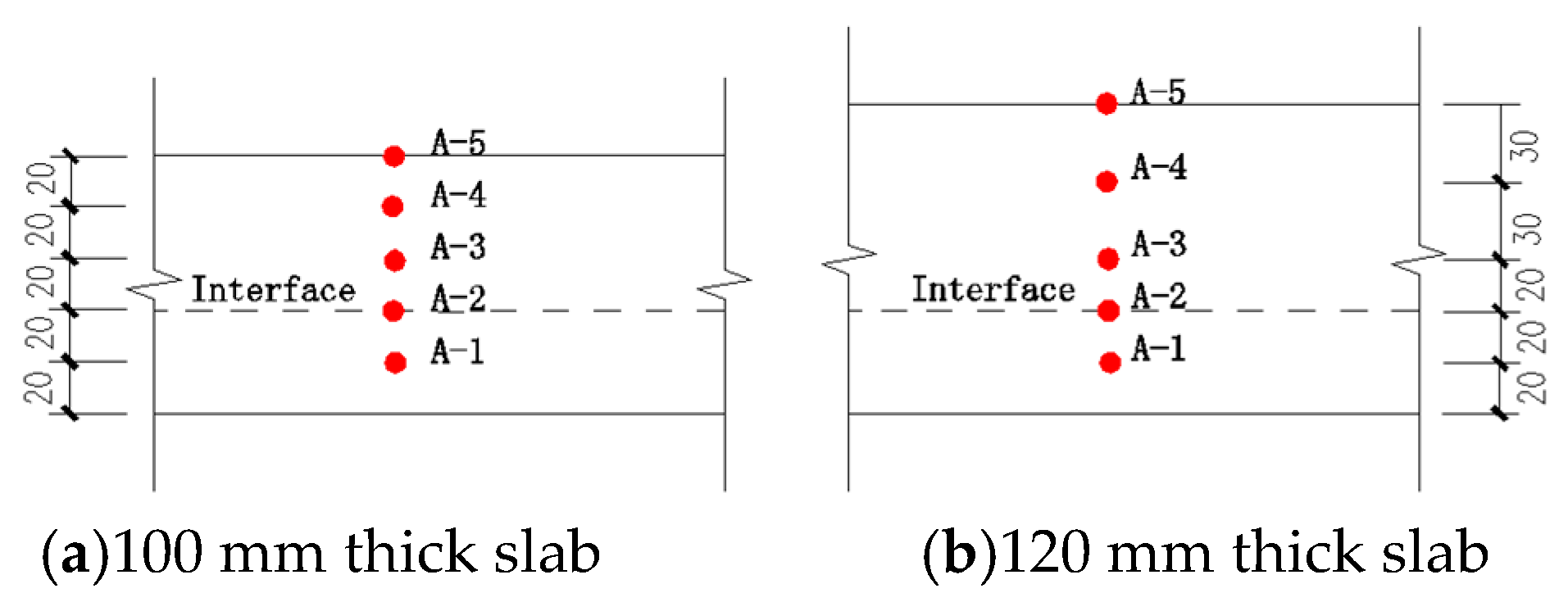


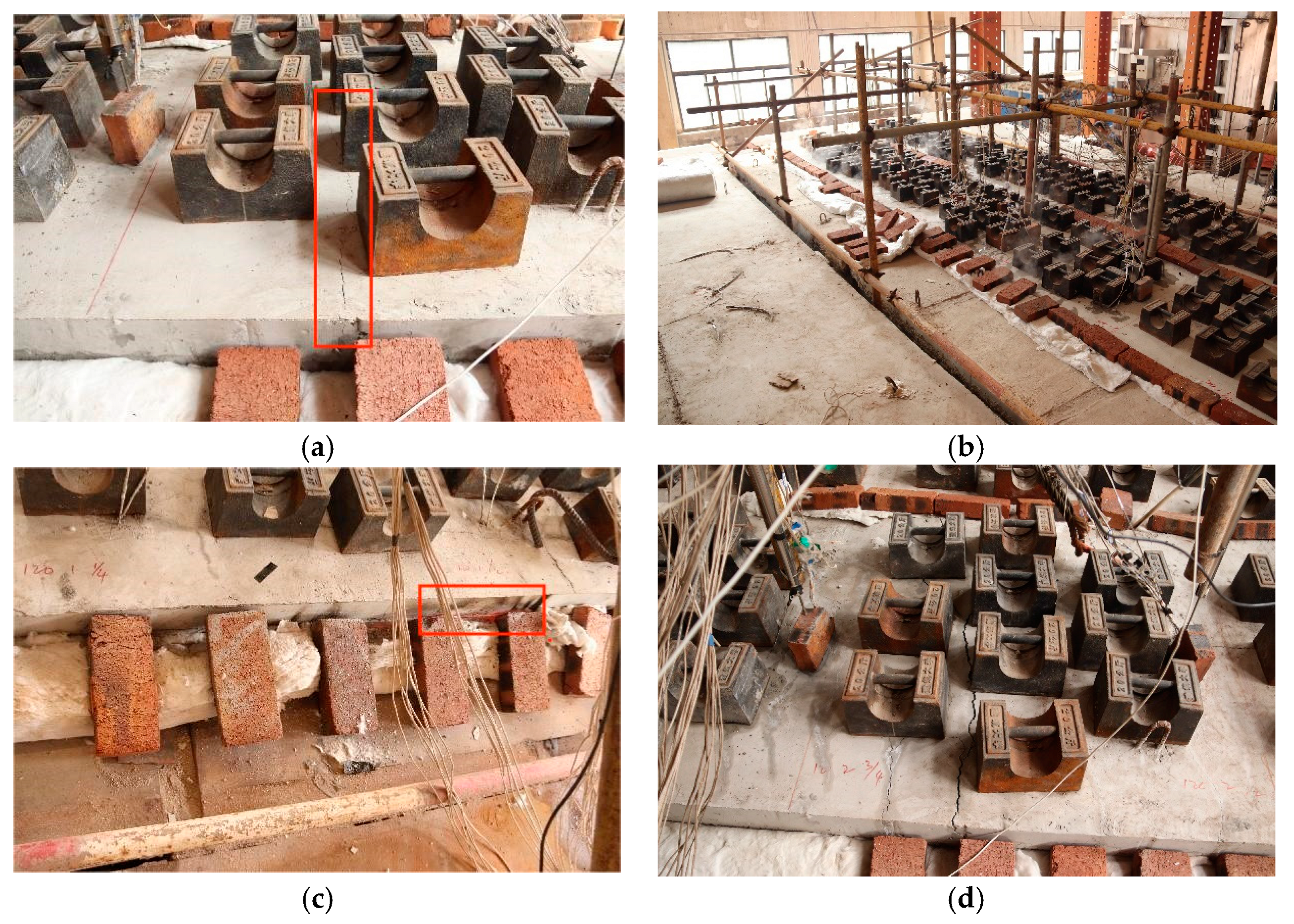
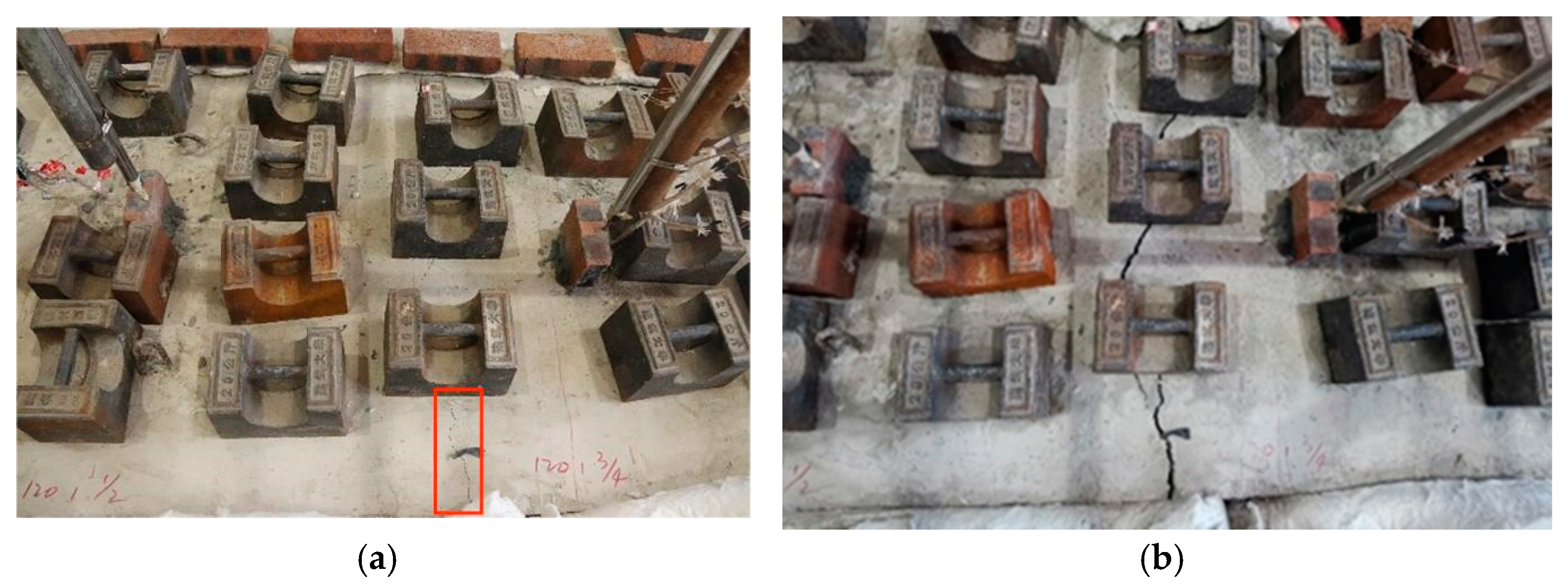
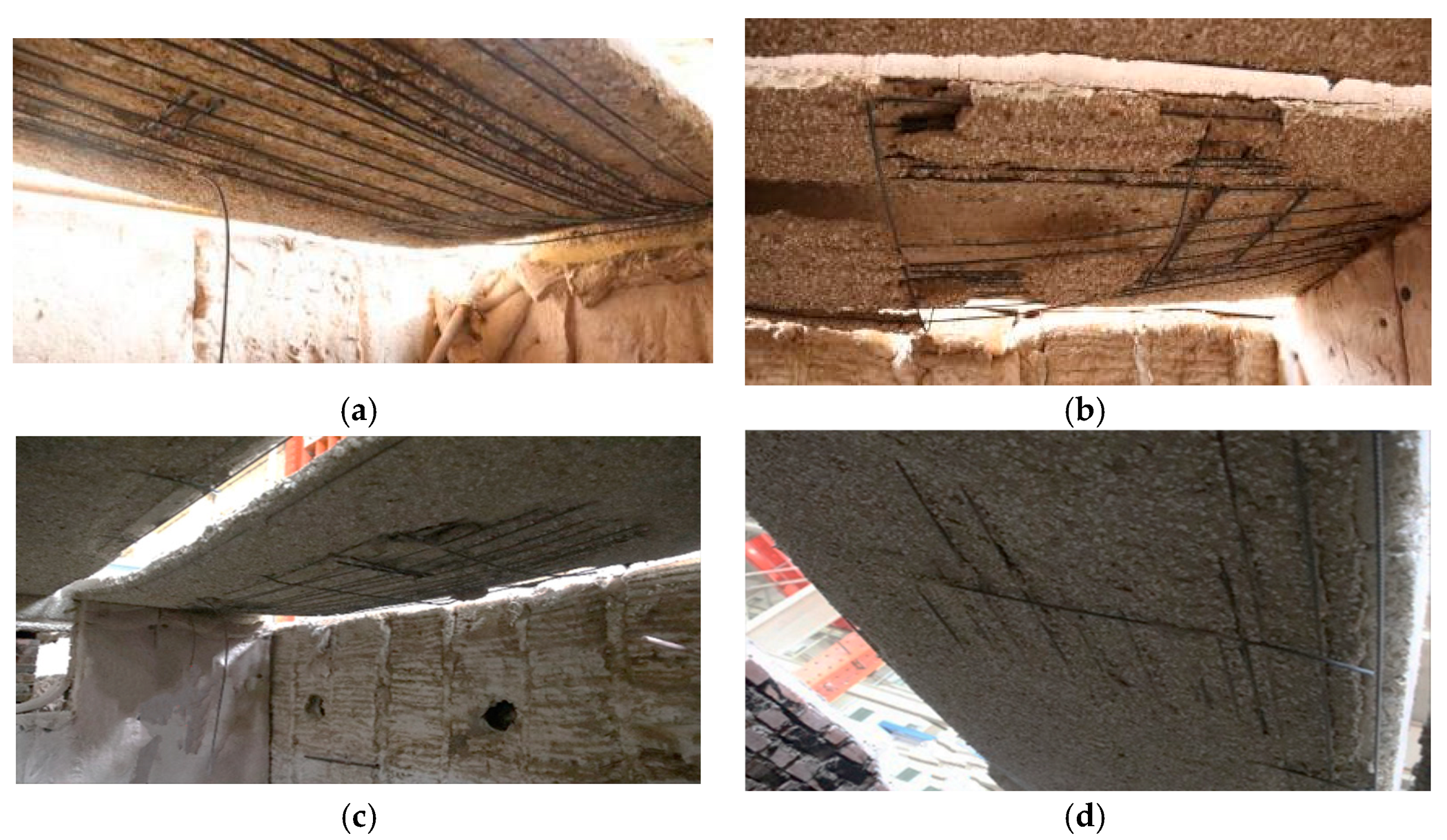
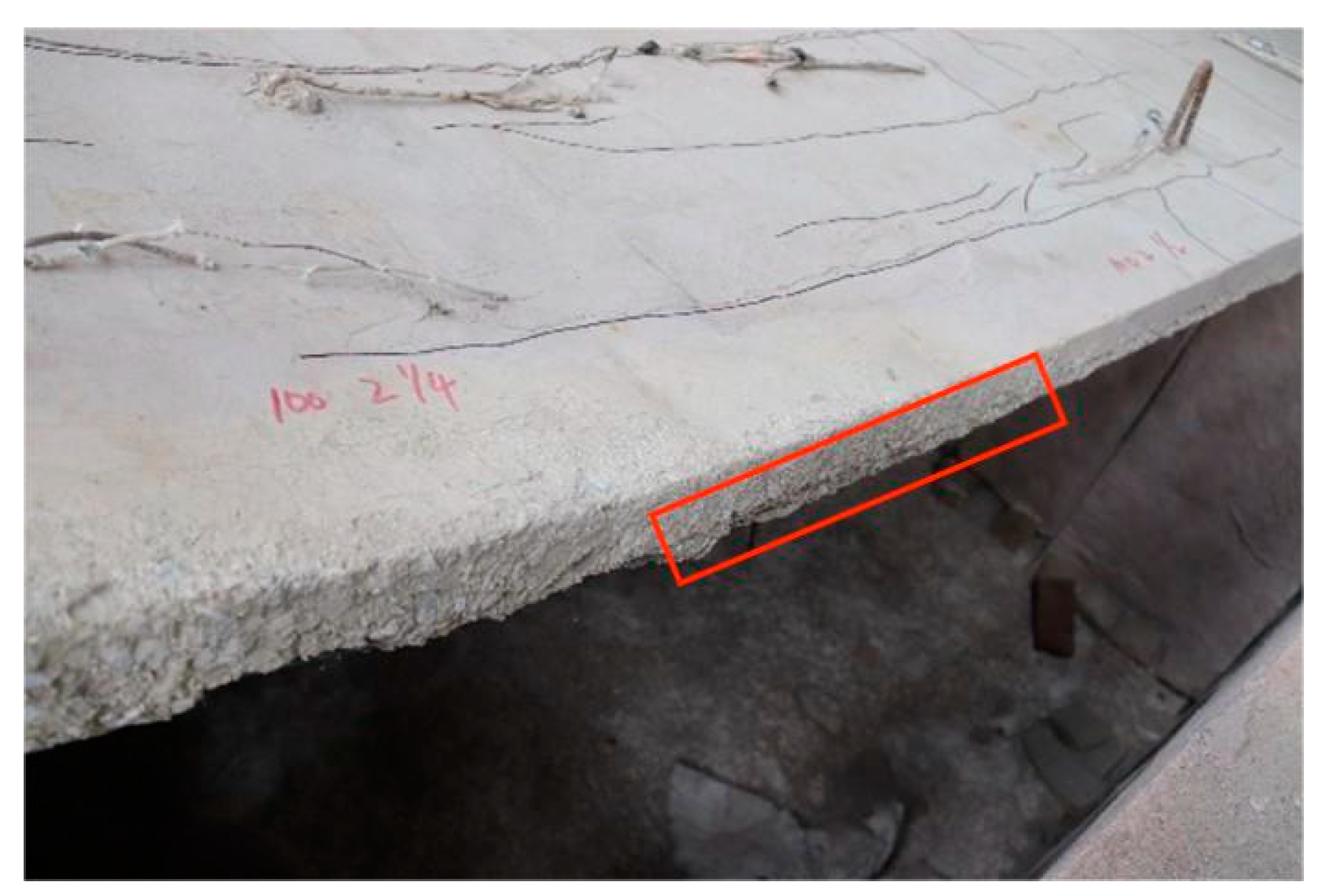
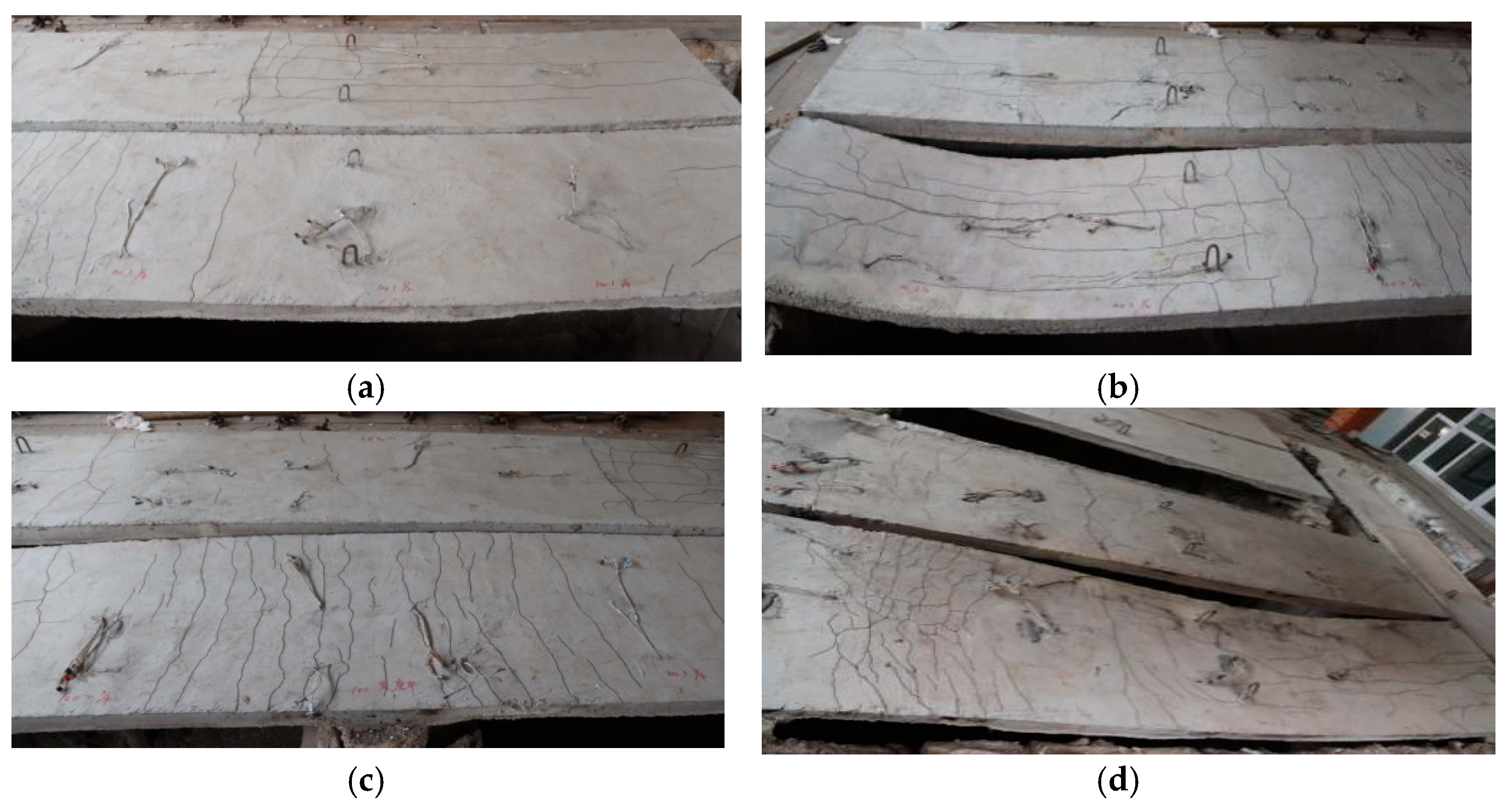

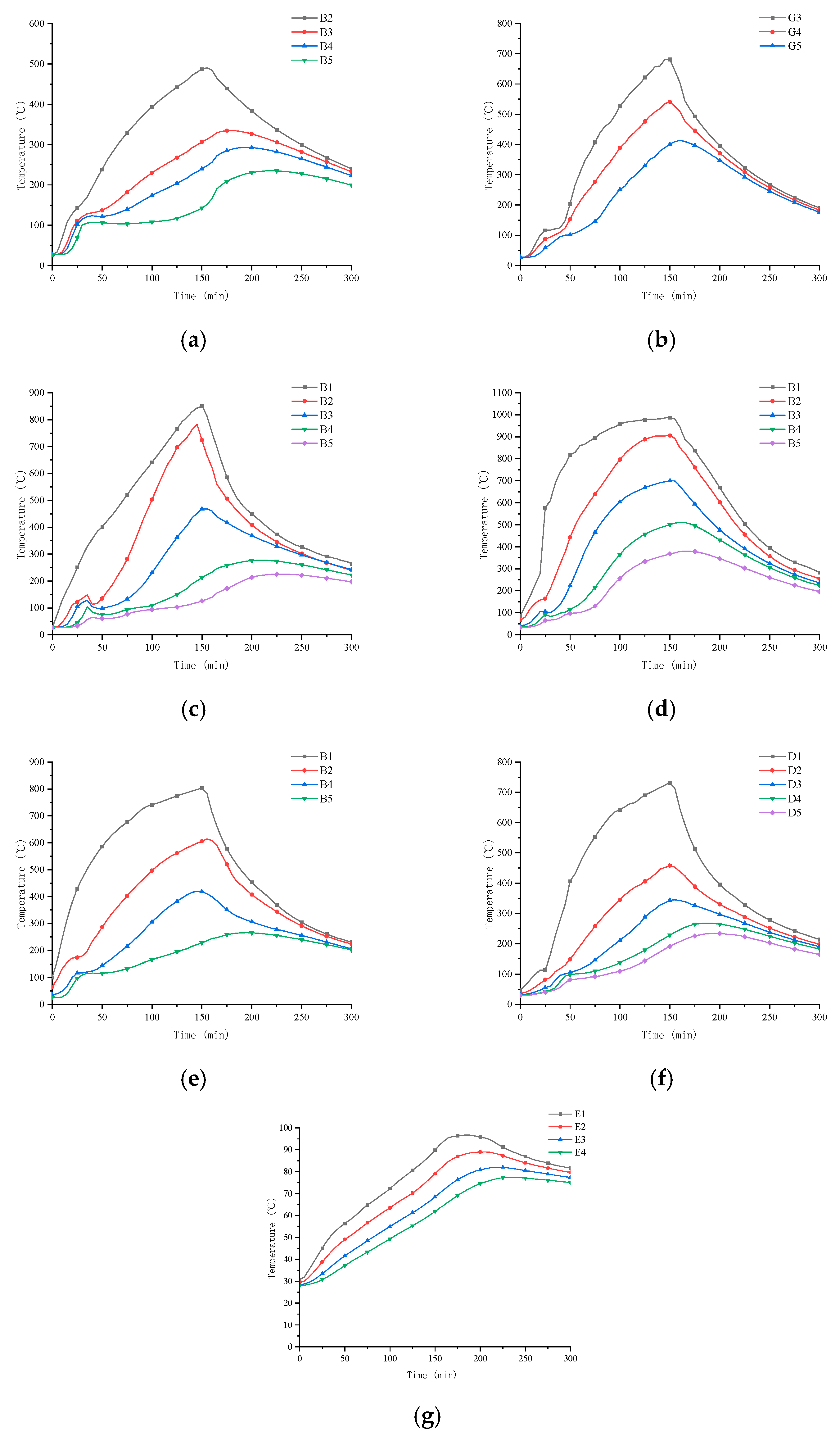
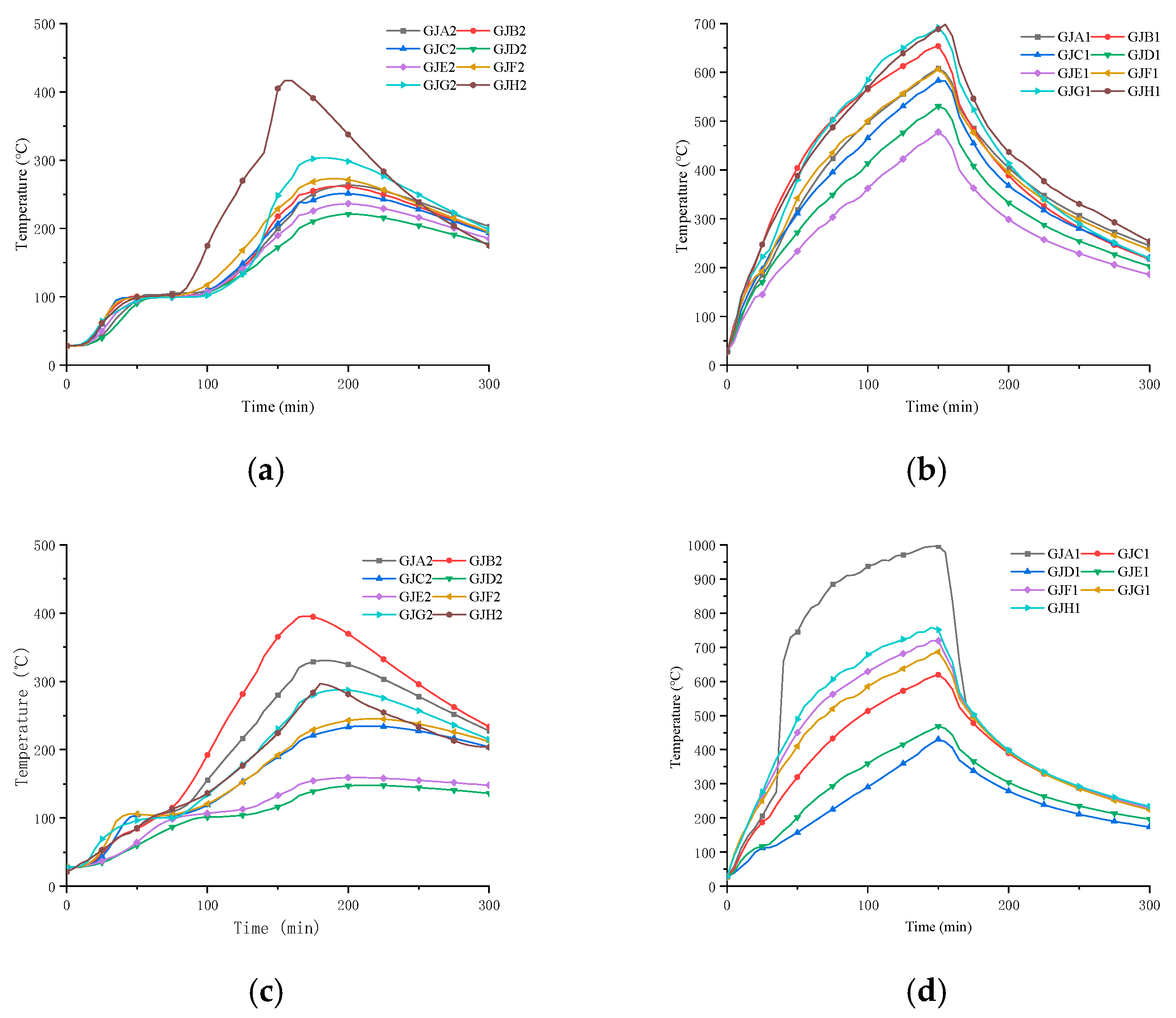
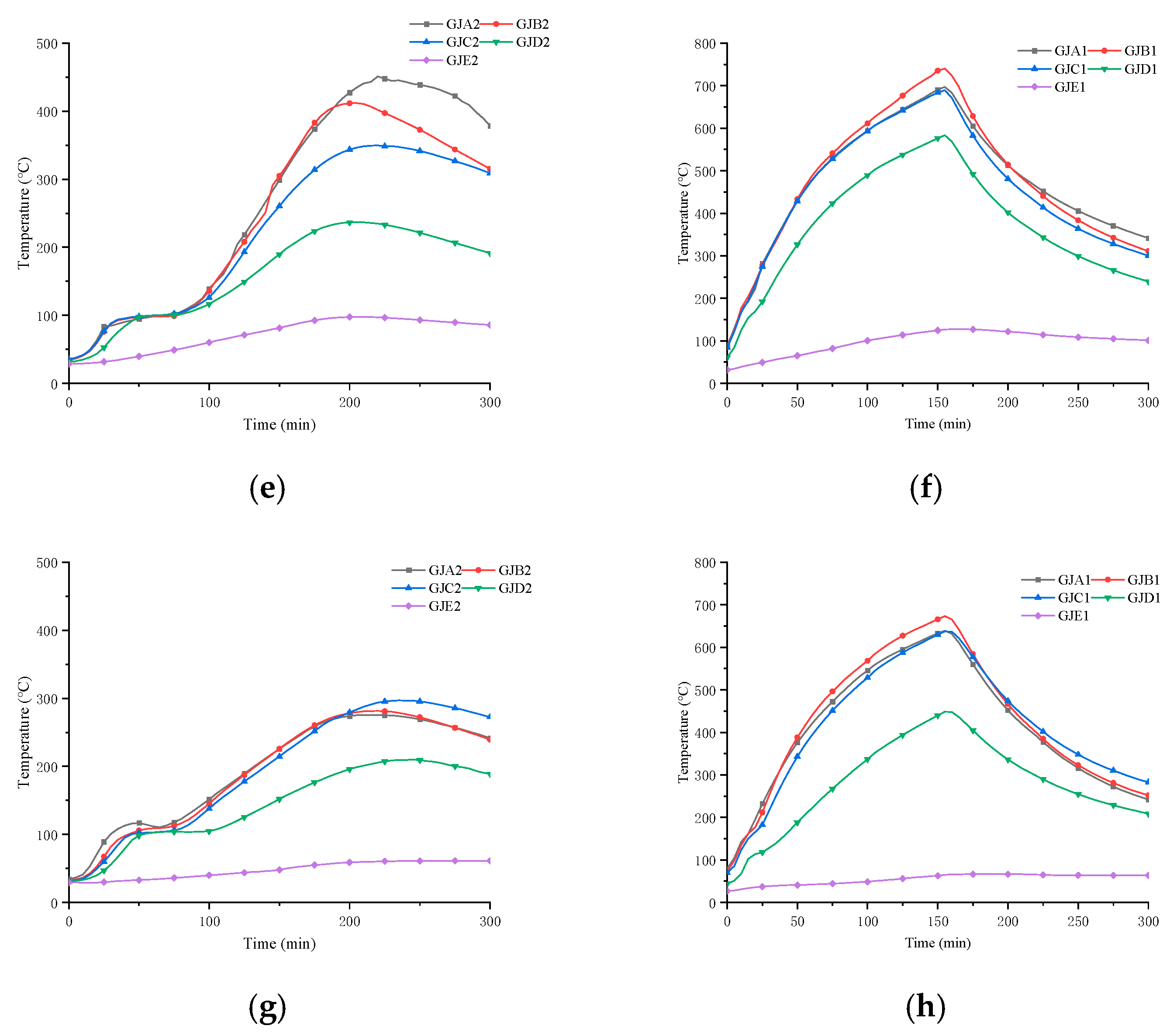
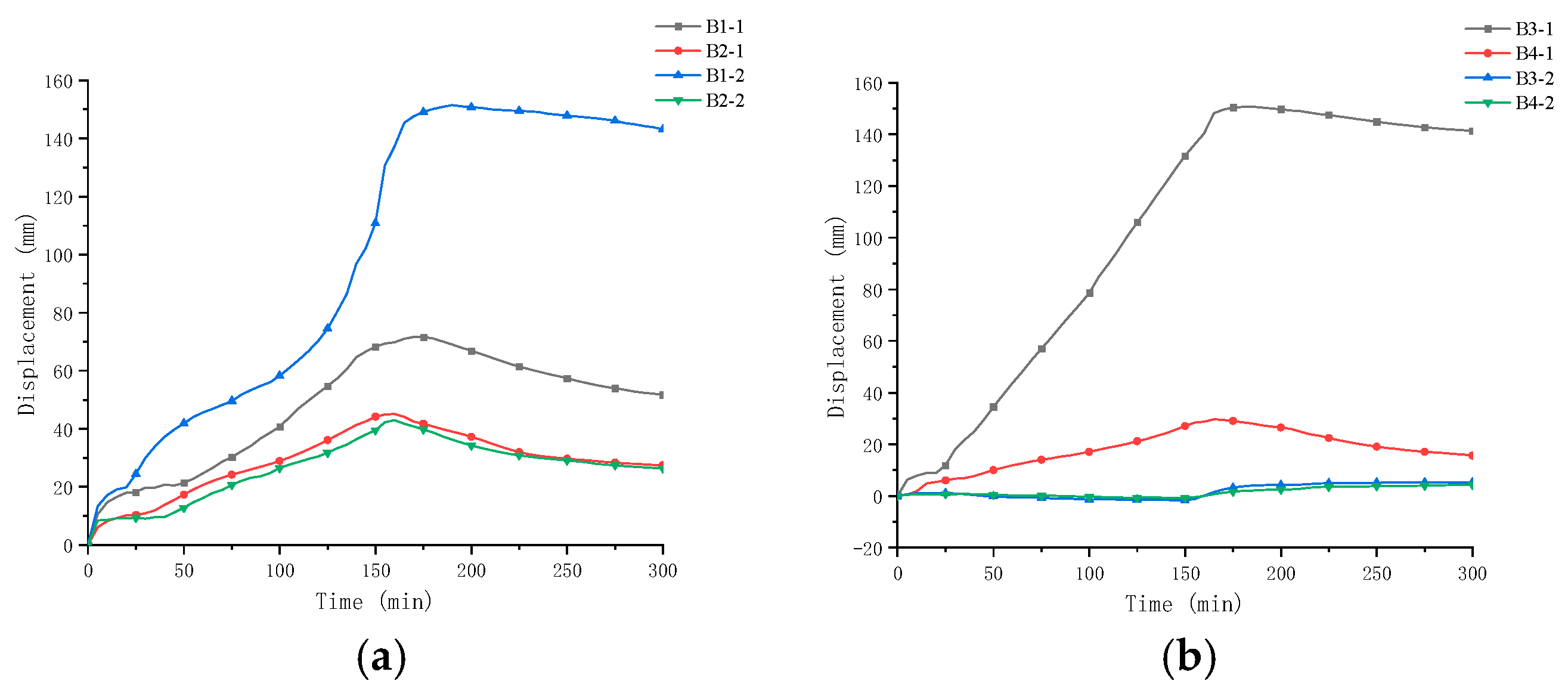
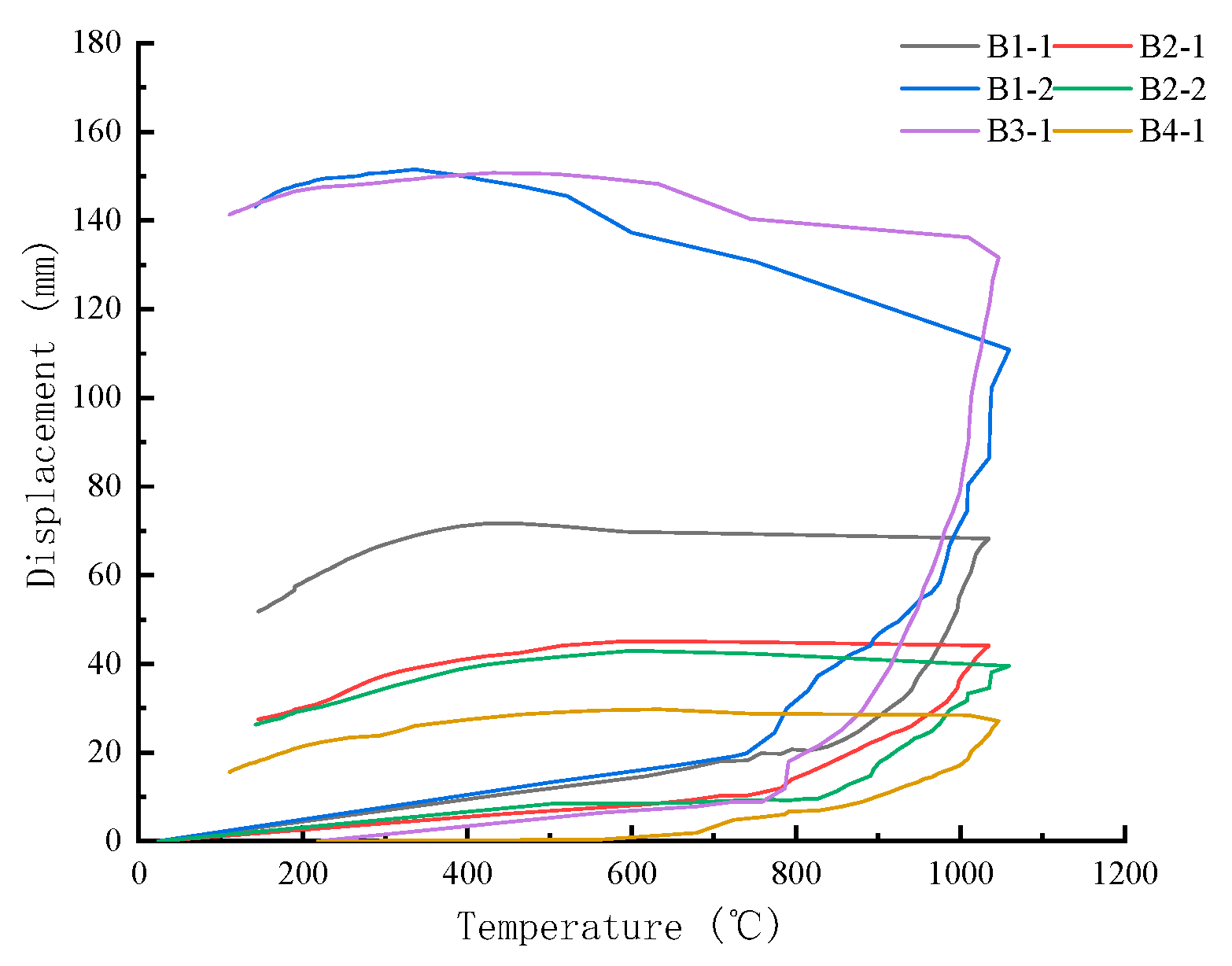
| Specimen | Termination Time of the Experiment (s) | Maximum Deflection (mm) | Prescribed Deflection Limit (mm) | Maximum Bending Deformation Rate (mm/min) | Prescribed Limit of Bending Deformation Rate (mm/min) |
|---|---|---|---|---|---|
| B1-1 | 150 | 71.6 | 287 | 2.1 | 12.8 |
| B1-2 | 150 | 169.3 | 287 | 4.7 | 12.8 |
| B2-1 | 150 | 72.7 | 239 | 2.5 | 10.6 |
| B2-2 | 150 | 46.4 | 239 | 1.7 | 10.6 |
| B3-1 | 153 | 153.8 | 287 | 1.6 | 12.8 |
| B4-1 | 153 | 44.3 | 239 | 0.79 | 10.6 |
| Specimen | Time with an Average Temperature Difference Greater Than 140 °C (min) | Temperature Difference at a Specific Point Exceeds 180 °C | |
|---|---|---|---|
| Time Point (min) | Measurement Point | ||
| B1 | 130 | 90 | G5 |
| B2 | >150 | 130 | H5 |
| B3 | 95 | 91 | B5 |
| B4 | >150 | 135 | B5 |
Disclaimer/Publisher’s Note: The statements, opinions and data contained in all publications are solely those of the individual author(s) and contributor(s) and not of MDPI and/or the editor(s). MDPI and/or the editor(s) disclaim responsibility for any injury to people or property resulting from any ideas, methods, instructions or products referred to in the content. |
© 2023 by the authors. Licensee MDPI, Basel, Switzerland. This article is an open access article distributed under the terms and conditions of the Creative Commons Attribution (CC BY) license (https://creativecommons.org/licenses/by/4.0/).
Share and Cite
Zhao, K.; Liu, S.; Li, J.; Fan, Z. Fire Resistance of Prestressed Multispan Steel Truss Composite Slab. Buildings 2024, 14, 80. https://doi.org/10.3390/buildings14010080
Zhao K, Liu S, Li J, Fan Z. Fire Resistance of Prestressed Multispan Steel Truss Composite Slab. Buildings. 2024; 14(1):80. https://doi.org/10.3390/buildings14010080
Chicago/Turabian StyleZhao, Kaozhong, Sihong Liu, Jinglu Li, and Zijia Fan. 2024. "Fire Resistance of Prestressed Multispan Steel Truss Composite Slab" Buildings 14, no. 1: 80. https://doi.org/10.3390/buildings14010080
APA StyleZhao, K., Liu, S., Li, J., & Fan, Z. (2024). Fire Resistance of Prestressed Multispan Steel Truss Composite Slab. Buildings, 14(1), 80. https://doi.org/10.3390/buildings14010080





